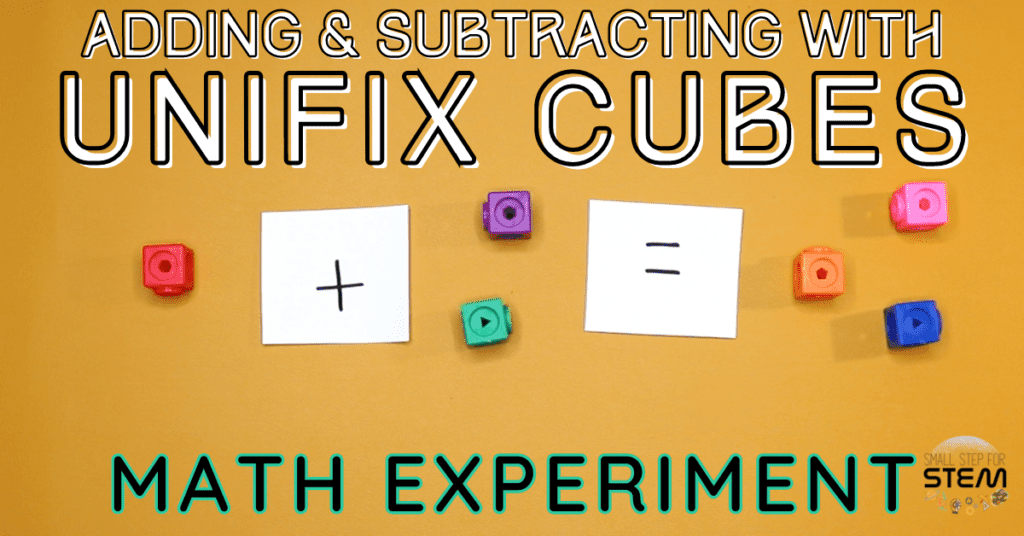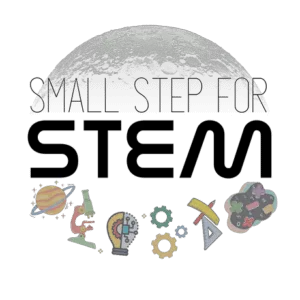Disclosure: this post contains affiliate links, which means I may receive a commission if you click a link and purchase something at no extra cost to you. Please check out our policies page for more details.
for more details.
We have another easy math experiment for you today with our handy Unifix cubes!
Addition and subtraction can easily be taught to children using concrete tools, like Unifix cubes. It builds a good foundation to see objects added or taken away from a pile of cubes and helps a young child understand the concepts of addition and subtraction.
We started doing simple addition and subtraction when our oldest was 3 years old by incorporating it into everyday life. For example: if we asked her to take 3 more bites at the dinner table, we would hold up 3 fingers. Once she took 1 bite, we would take away one finger and say “3 minus 1 is…? 2!”.
This was how we built a foundation with addition and subtraction in our home. One other way to build a foundation for early math is by using Unifix cubes and playing with a math experiment!

How to make the Adding and Subtracting with Unifix Cubes math experiment
Supplies you will need
For this experiment, you will need the following:
- Unifix Cubes

- Printer paper
- Marker
- Scissors

Before you start
Since Unifix cubes are a choking hazard for young children, keep track of where the cubes are and that no one puts them in their mouth.
Also, we are using scissors in this experiment, so keep a close on your child.
Instructions
Here is how to do the Addition and Subtracting with Unifix Cubes experiment:
Step 1: Draw + – = on printer paper

Draw each sign out on printer paper with your marker, leaving about an inch around them to cut them out.
An alternative to using the math signs is to write out an actual equation for each equation you solve together.
An example of this would be to write out 5 + 2 = on the sheet of paper, then solve it in real time (like the picture at the top of this post).
Step 2: Cut out each sign

Go ahead and cut out each sign, leaving about an inch around the sign.
Step 3: Begin with 5 or less cubes and build math equations

When getting started with this experiment, especially if addition and subtraction are brand new topics to your child, it’s important to start small.
Having too many cubes on the table to play with adds a little bit of chaos to what could be an overwhelming experiment.
We will start out by having 5 total cubes on the table to use for addition and subtraction.
Ask questions like:
- What is 1 plus 2? – show one cube on one side and two cubes on another, then combine them
- What is 3 minus 1? – show three cubes and remove one cube to the other side
Get your child involved: Once you show your child a few math problems with the cubes, see if they are willing to create their own equations and solve them!
Step 4: Once they are comfortable with the first step, use 10 cubes total to do math equations

Kick up the experiment a little by adding more cubes into the mix.
I like to keep the maximum amount of cubes to 10 for this stage because we typically do addition and subtraction equations with our hands at the dinner table. If your child is comfortable with using 20 cubes, go for it!
The key is to meet your child where they’re at. If using 20 cubes seems too overwhelming, sticking to 10 cubes still drives the lesson home during this experiment.
Step 5: Incorporate colors

Here’s a little hidden lesson inside this math experiment: color identification!
You could ask questions like “what do we get when we add 3 blue cubes to 2 green cubes?”. It’s just another way to do the experiment while also identifying colors.
The math behind the Adding and Subtracting with Unifix Cubes math experiment
This experiment teaches:
- An introduction to addition and subtraction
- Counting
- Colors
How it works
Using Unifix cubes to add and subtract is a hands-on, concrete way to learn these mathematical concepts. When you are teaching these math topics to a young child, something they can hold in their hands and physically see objects being added or subtracted to a pile really drives home the topic.
Introduction to addition and subtraction
Addition and subtraction are easy math topics to introduce to even a young child, like a preschooler. It’s best introduced with more concrete objects, and Unifix cubes are excellent to get started.
A simple explanation of addition and subtraction to a preschooler might look like this:
- Addition is taking two piles of cubes and combining them, then counting the newly combined pile
- Subtraction is having one pile of cubes and taking away some cubes, then counting what is left
In this math experiment, we are showing how to add and subtract from a preset amount of Unifix cubes.
Whether you choose to create a pile of 5 Unifix cubes and add/subtract from the pile or to connect 5 cubes and pop cubes on and off, it gives your child a great, concrete example of what it means to add numbers to each other and subtract numbers from one another.
Counting
This experiment covers even more than just addition and subtraction: there’s also a hidden lesson in one-to-one correspondence (where each object can only be counted once).
If your child struggles with counting individual objects and instead recites 1-10 when you ask how many there are of something, this would be a great lesson to introduce to them.
When adding cubes (especially if your child is struggling with one-to-one correspondence), take your time counting each individual cube as you add them to the pile. The same goes for subtracting: carefully count each individual cube as you remove it.
Colors
If you are using a set of Unifix cubes with several different colors, this is a great opportunity to incorporate color recognition into the experiment.
For example:
- “Let’s subtract all of the yellow cubes from this pile.”
- “Can you add up how many green cubes we have?”
- “If we add 3 blue cubes to 2 yellow cubes, how many do we get?”
More math experiments with Unifix cubes to try out with your child
- Measuring with Unifix cubes: Non-standard units to introduce measuring height
- Building patterns with Unifix cubes: A colorful introduction to patterns
FAQ about the Adding and Subtracting with Unifix Cubes math experiment
How do you explain subtraction to a preschooler?
Subtraction can be explained easily with Unifix cubes. Starting with a small pile of cubes, tell your child that subtraction is taking some cubes away from the pile and seeing what is left.
This could sound like, “we have 5 cubes in our pile. I want to take away 2 cubes. So, what is 5 minus 2?”.
Related experiments
Adding and subtracting can be a fun game using playing cards with your child. Teaching your child early math like addition and subtraction can be simple, especially when using tangible items like...
This fun homemade calculator will encourage your child to learn simple addition while creating a chute for all the items you'll be adding together! Introducing simple addition concepts to a child...
